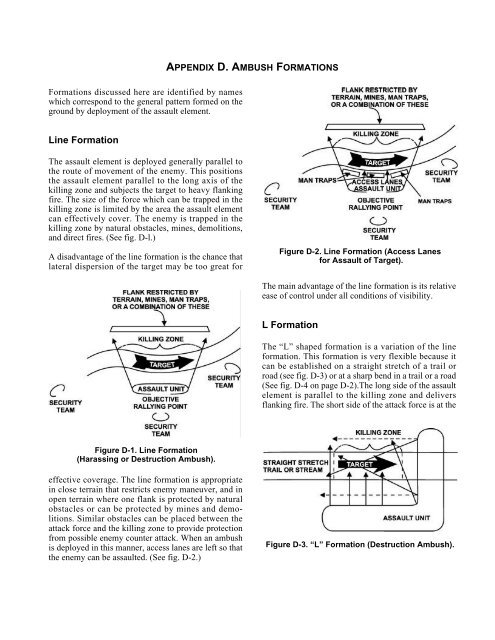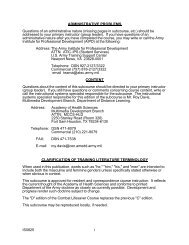MCWP-3-11.3-Scouting-and-Patrolling
MCWP-3-11.3-Scouting-and-Patrolling
MCWP-3-11.3-Scouting-and-Patrolling
You also want an ePaper? Increase the reach of your titles
YUMPU automatically turns print PDFs into web optimized ePapers that Google loves.
APPENDIX D. AMBUSH FORMATIONSFormations discussed here are identified by nameswhich correspond to the general pattern formed on theground by deployment of the assault element.Line FormationThe assault element is deployed generally parallel tothe route of movement of the enemy. This positionsthe assault element parallel to the long axis of thekilling zone <strong>and</strong> subjects the target to heavy flankingfire. The size of the force which can be trapped in thekilling zone is limited by the area the assault elementcan effectively cover. The enemy is trapped in thekilling zone by natural obstacles, mines, demolitions,<strong>and</strong> direct fires. (See fig. D-l.)A disadvantage of the line formation is the chance thatlateral dispersion of the target may be too great forFigure D-2. Line Formation (Access Lanesfor Assault of Target).The main advantage of the line formation is its relativeease of control under all conditions of visibility.L FormationThe “L” shaped formation is a variation of the lineformation. This formation is very flexible because itcan be established on a straight stretch of a trail orroad (see fig. D-3) or at a sharp bend in a trail or a road(See fig. D-4 on page D-2).The long side of the assaultelement is parallel to the killing zone <strong>and</strong> deliversflanking fire. The short side of the attack force is at theFigure D-1. Line Formation(Harassing or Destruction Ambush).effective coverage. The line formation is appropriatein close terrain that restricts enemy maneuver, <strong>and</strong> inopen terrain where one flank is protected by naturalobstacles or can be protected by mines <strong>and</strong> demolitions.Similar obstacles can be placed between theattack force <strong>and</strong> the killing zone to provide protectionfrom possible enemy counter attack. When an ambushis deployed in this manner, access lanes are left so thatthe enemy can be assaulted. (See fig. D-2.)Figure D-3. “L” Formation (Destruction Ambush).



